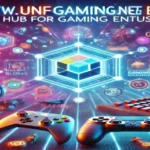Introduction to DGLux 5 for Niagara 4.10
Are you looking to elevate your building automation experience? Enter DGLux 5 for Niagara 4.10—a powerhouse combination that promises to transform the way you visualize and manage your systems. With the rise of smart buildings, having an intuitive, user-friendly interface is more critical than ever. DGLux 5 complements Niagara 4.10 by providing a dynamic visual platform that’s not just about aesthetics; it’s about functionality and efficiency.
Imagine being able to create stunning dashboards that capture real-time data effortlessly while optimizing energy management and control operations. Whether you’re a facility manager or an integrator, mastering DGLux 5 can unlock new possibilities in system integration and performance monitoring. Dive into this guide as we explore everything from its features to integration tips, ensuring you harness the full potential of DGLux 5 for Niagara 4.10!
Benefits of using DGLux 5 for Niagara 4.10
DGLux 5 brings a host of benefits to the Niagara 4.10 platform, enhancing user experience and engagement. Its intuitive interface simplifies complex tasks, allowing users to design stunning dashboards with ease.
One significant advantage is its ability to visualize real-time data effectively. With dynamic graphics and customizable widgets, users can monitor system performance at a glance.
Seamless integration with existing Niagara systems boosts productivity. DGLux 5 allows for quick updates and modifications without extensive coding knowledge.
Moreover, it supports various protocols, ensuring compatibility across different devices and platforms. This flexibility opens doors for better collaboration among teams working on diverse projects.
Users also appreciate enhanced analytics capabilities. Precise data insights lead to informed decision-making and improved operational efficiency within facilities management or building automation environments.
Features and capabilities of DGLux 5 for Niagara 4.10
DGLux 5 for Niagara 4.10 offers a rich set of features that enhance user experience and system performance. This visual design tool allows users to create stunning dashboards with ease. Its drag-and-drop functionality makes it accessible, even for those without extensive programming skills.
The platform supports real-time data visualization, empowering users to make informed decisions quickly. With customizable widgets, you can tailor your interface to specific needs or preferences.
Integration with third-party applications is seamless, allowing for expanded capabilities and improved workflows. DGLux also provides robust analytics tools that help in tracking performance metrics effectively.
Collaboration is simplified through its sharing options, enabling teams to work together effortlessly on projects. The built-in library of templates accelerates the design process while ensuring consistency across applications.
How to integrate DGLux 5 with Niagara 4.10
Integrating DGLux 5 with Niagara 4.10 is a streamlined process that enhances your building management capabilities. Start by ensuring you have the latest versions of both platforms installed.
First, open your Niagara Workbench and navigate to the module manager. Here, you can add DGLux as an extension. This allows for seamless communication between systems.
Next, configure your data sources within DGLux 5. Use the built-in connectors specifically designed for Niagara 4.10 to ensure accurate data flow and real-time updates.
Once set up, take advantage of DGLux’s visual analytics tools to create intuitive dashboards that reflect live-building data from Niagara.
Test the integration thoroughly before going live to confirm everything works smoothly together. This ensures users experience optimal performance without hitches or delays in information display.
Case studies of successful DGLux 5 and Niagara 4.10 integrations
Several organizations have successfully harnessed the power of DGLux 5 for Niagara 4.10, resulting in enhanced operational efficiency and improved user experience.
One notable case involved a large commercial building where DGLux 5 streamlined energy management systems. The integration allowed real-time monitoring of HVAC performance, reducing energy costs significantly.
Another success story comes from the healthcare sector. A hospital utilized DGLux 5 to create interactive dashboards for their facility management team. This enabled quick access to critical data, leading to faster decision-making and better resource allocation.
In educational settings, a university adopted DGLux 5 to visualize campus utilities. Students and staff gained insights into energy consumption patterns, fostering a culture of sustainability on campus.
These examples illustrate how diverse sectors benefit from integrating DGLux 5 with Niagara 4.10 efficiently and creatively.
Tips and tricks for maximizing the use of DGLux
Maximizing the use of DGLux 5 for Niagara 4.10 involves a few key strategies that can enhance user experience and efficiency. Start by familiarizing yourself with the built-in templates and widgets available in DGLux. These tools can significantly speed up your development process.
Consider investing time in learning about data visualization best practices. Clear, compelling visuals can make complex data sets easier to interpret, driving better insights from your analytics.
Utilize responsive design features within DGLux to ensure that your dashboards look great on any device. This flexibility is crucial as more users access systems through mobile platforms.
Regularly update both DGLux and Niagara software to take advantage of new features and security improvements. Staying current helps avoid compatibility issues down the line.
Engage with online communities or forums focused on DGLux 5 for Niagara 4.10 integration. Sharing experiences or troubleshooting challenges with others can lead to valuable tips you might not have considered before.
Don’t hesitate to experiment! The true power of DGLux lies in its versatility; testing various layouts or configurations could yield unexpected benefits for your specific needs.

















